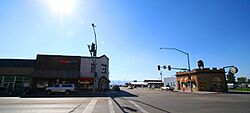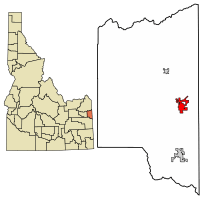Driggs, Idaho facts for kids
Quick facts for kids
Driggs, Idaho
|
|
|---|---|

Driggs in 2006
|
|
| Motto(s):
The heart of Teton Valley
|
|

Location of Driggs in Teton County, Idaho
|
|
| Country | United States |
| State | Idaho |
| County | Teton |
| Area | |
| • Total | 2.92 sq mi (7.56 km2) |
| • Land | 2.92 sq mi (7.56 km2) |
| • Water | 0.00 sq mi (0.00 km2) |
| Elevation | 6,145 ft (1,873 m) |
| Population
(2010)
|
|
| • Total | 1,660 |
| • Estimate
(2019)
|
1,817 |
| • Density | 622.90/sq mi (240.50/km2) |
| Time zone | UTC-7 (Mountain (MST)) |
| • Summer (DST) | UTC-6 (MDT) |
| ZIP code |
83422
|
| Area codes | 208, 986 |
| FIPS code | 16-22690 |
| GNIS feature ID | 2410356 |
Driggs is a city in the eastern part of Idaho, a state in the western U.S.. It is the main city, or county seat, of Teton County. Driggs is located in a beautiful area called Teton Valley, which is where the Teton River begins.
In 2010, about 1,660 people lived in Driggs. This was more than the 1,100 people who lived there in 2000. The city has its own airport, the Driggs-Reed Memorial Airport. It has a long runway that private planes can use.
Contents
History of Driggs
The area around Teton Valley was first explored by John Colter in 1808. He was part of the famous Lewis and Clark Expedition. Later, this valley became known as Pierre's Hole. This name honored a fur trapper called "le grand Pierre" Tivanitagon.
In 1832, a big meeting of fur trappers and traders, called the Rendezvous, happened here. After the meeting, there was a conflict known as the Battle of Pierre's Hole.
The city of Driggs was started in 1888 by Benjamin Woodbury Driggs, Jr. and Don Carlos Driggs. Their family later moved to Arizona. There, they started a company called Western Savings and Loan. A descendant, John Driggs, even became the mayor of Phoenix, Arizona in the 1970s.
In 2007, National Geographic magazine said Driggs was one of the top 10 places in the U.S. for outdoor fun. The Wall Street Journal suggested in 2023 that Driggs might become like Jackson Hole. This is because the Grand Targhee Resort nearby is growing.
Geography and Climate
Driggs is a city built on land, covering about 2.76 square miles (7.15 square kilometers).
Weather in Driggs
Driggs has a climate with big changes in temperature throughout the year. Summers are warm, and winters are cold, sometimes very cold. This type of weather is called a humid continental climate.
| Climate data for Driggs, Idaho, 1991–2020 normals, extremes 1904–present | |||||||||||||
|---|---|---|---|---|---|---|---|---|---|---|---|---|---|
| Month | Jan | Feb | Mar | Apr | May | Jun | Jul | Aug | Sep | Oct | Nov | Dec | Year |
| Record high °F (°C) | 60 (16) |
60 (16) |
72 (22) |
80 (27) |
89 (32) |
95 (35) |
100 (38) |
98 (37) |
96 (36) |
85 (29) |
71 (22) |
65 (18) |
100 (38) |
| Mean maximum °F (°C) | 43.7 (6.5) |
46.4 (8.0) |
56.0 (13.3) |
67.9 (19.9) |
76.8 (24.9) |
83.5 (28.6) |
87.5 (30.8) |
87.4 (30.8) |
82.1 (27.8) |
73.1 (22.8) |
58.9 (14.9) |
46.3 (7.9) |
89.0 (31.7) |
| Mean daily maximum °F (°C) | 32.8 (0.4) |
36.0 (2.2) |
44.3 (6.8) |
53.9 (12.2) |
64.6 (18.1) |
73.2 (22.9) |
82.9 (28.3) |
81.8 (27.7) |
72.7 (22.6) |
58.1 (14.5) |
43.7 (6.5) |
32.8 (0.4) |
56.4 (13.6) |
| Daily mean °F (°C) | 21.0 (−6.1) |
24.2 (−4.3) |
32.3 (0.2) |
40.7 (4.8) |
49.9 (9.9) |
57.2 (14.0) |
65.2 (18.4) |
63.7 (17.6) |
55.5 (13.1) |
43.4 (6.3) |
31.4 (−0.3) |
21.7 (−5.7) |
42.2 (5.7) |
| Mean daily minimum °F (°C) | 9.3 (−12.6) |
12.3 (−10.9) |
20.3 (−6.5) |
27.5 (−2.5) |
35.2 (1.8) |
41.2 (5.1) |
47.5 (8.6) |
45.6 (7.6) |
38.2 (3.4) |
28.7 (−1.8) |
19.0 (−7.2) |
10.5 (−11.9) |
27.9 (−2.2) |
| Mean minimum °F (°C) | −14.5 (−25.8) |
−9.9 (−23.3) |
0.2 (−17.7) |
14.1 (−9.9) |
22.2 (−5.4) |
30.4 (−0.9) |
38.1 (3.4) |
35.3 (1.8) |
25.5 (−3.6) |
14.1 (−9.9) |
−1.6 (−18.7) |
−11.4 (−24.1) |
−18.2 (−27.9) |
| Record low °F (°C) | −44 (−42) |
−50 (−46) |
−30 (−34) |
−11 (−24) |
8 (−13) |
21 (−6) |
25 (−4) |
13 (−11) |
9 (−13) |
−7 (−22) |
−25 (−32) |
−40 (−40) |
−50 (−46) |
| Average precipitation inches (mm) | 1.95 (50) |
1.07 (27) |
1.37 (35) |
1.90 (48) |
2.30 (58) |
1.97 (50) |
1.06 (27) |
1.23 (31) |
1.47 (37) |
1.77 (45) |
1.52 (39) |
1.74 (44) |
19.35 (491) |
| Average snowfall inches (cm) | 15.7 (40) |
8.7 (22) |
8.8 (22) |
3.7 (9.4) |
0.4 (1.0) |
0.1 (0.25) |
0.0 (0.0) |
0.0 (0.0) |
0.1 (0.25) |
2.6 (6.6) |
9.6 (24) |
19.1 (49) |
68.8 (174.5) |
| Average precipitation days (≥ 0.01 in) | 8.3 | 5.7 | 5.4 | 7.7 | 8.5 | 6.5 | 5.3 | 5.7 | 5.0 | 5.3 | 4.9 | 6.5 | 74.8 |
| Average snowy days (≥ 0.1 in) | 8.1 | 4.1 | 2.9 | 1.7 | 0.2 | 0.0 | 0.0 | 0.0 | 0.0 | 1.2 | 3.7 | 7.2 | 29.1 |
| Source 1: NOAA | |||||||||||||
| Source 2: National Weather Service | |||||||||||||
People of Driggs
| Historical population | |||
|---|---|---|---|
| Census | Pop. | %± | |
| 1920 | 683 | — | |
| 1930 | 719 | 5.3% | |
| 1940 | 1,040 | 44.6% | |
| 1950 | 941 | −9.5% | |
| 1960 | 824 | −12.4% | |
| 1970 | 727 | −11.8% | |
| 1980 | 727 | 0.0% | |
| 1990 | 846 | 16.4% | |
| 2000 | 1,100 | 30.0% | |
| 2010 | 1,660 | 50.9% | |
| 2019 (est.) | 1,817 | 9.5% | |
| U.S. Decennial Census | |||
Driggs Population in 2010
In 2010, the city of Driggs had 1,660 people living in 587 households. About 385 of these were families. The city had about 601 people per square mile.
Many households, about 40.7%, had children under 18 living with them. Most households, 50.6%, were married couples. About 22.5% of households were single people living alone. The average household had 2.82 people.
The average age of people in Driggs was 30.6 years old. About 29.2% of residents were under 18. About 33.9% were between 25 and 44 years old. The city had slightly more males (51.4%) than females (48.6%).
Arts and Fun in Driggs
Driggs offers many interesting places and events:
- An art gallery where you can see cool artworks.
- The Winter Snowfest, a festival with amazing snow sculptures.
- The Teton Valley Hot Air Balloon Festival, where colorful balloons fill the sky.
- Shakespeare in the Park, where plays are performed outdoors.
- The Plein Air Arts Festival, celebrating outdoor painting.
- A Geotourism Center, helping visitors explore the local area.
- "Music on Main," a series of free outdoor concerts in the summer.
- The SpudFest Family Film and Music Festival, which used to happen at the Spud Drive-In Theater.
Education in Driggs
The public schools in Teton County are run by Teton School District #401. Their main office is in Driggs. The only traditional high school in the county, Teton High School, is in Driggs. The city also has the county's middle school and upper elementary school.
The College of Eastern Idaho serves this county, but it's important to know that this county does not pay taxes to support that college.
Getting Around Driggs
Roads
Air Travel
- Driggs-Reed Memorial Airport is the local airport. Its airport codes are DIJ (IATA), KDIJ (ICAO), and DIJ (FAA).
Notable People from Driggs
Some well-known people have connections to Driggs:
- Hendrika B. Cantwell (born 1925), a professor who taught about children's health.
- Jeannine Davis-Kimball (1929–2017), an archaeologist who studied ancient cultures.
- Junius Driggs (1907-1994), a banker.
- Leon M. Lederman (1922-2018), a famous scientist who directed a big physics lab.
- Dawn Wells (1938-2020), an actress, lived part-time in Driggs.
Images for kids
See also
 In Spanish: Driggs (Idaho) para niños
In Spanish: Driggs (Idaho) para niños





